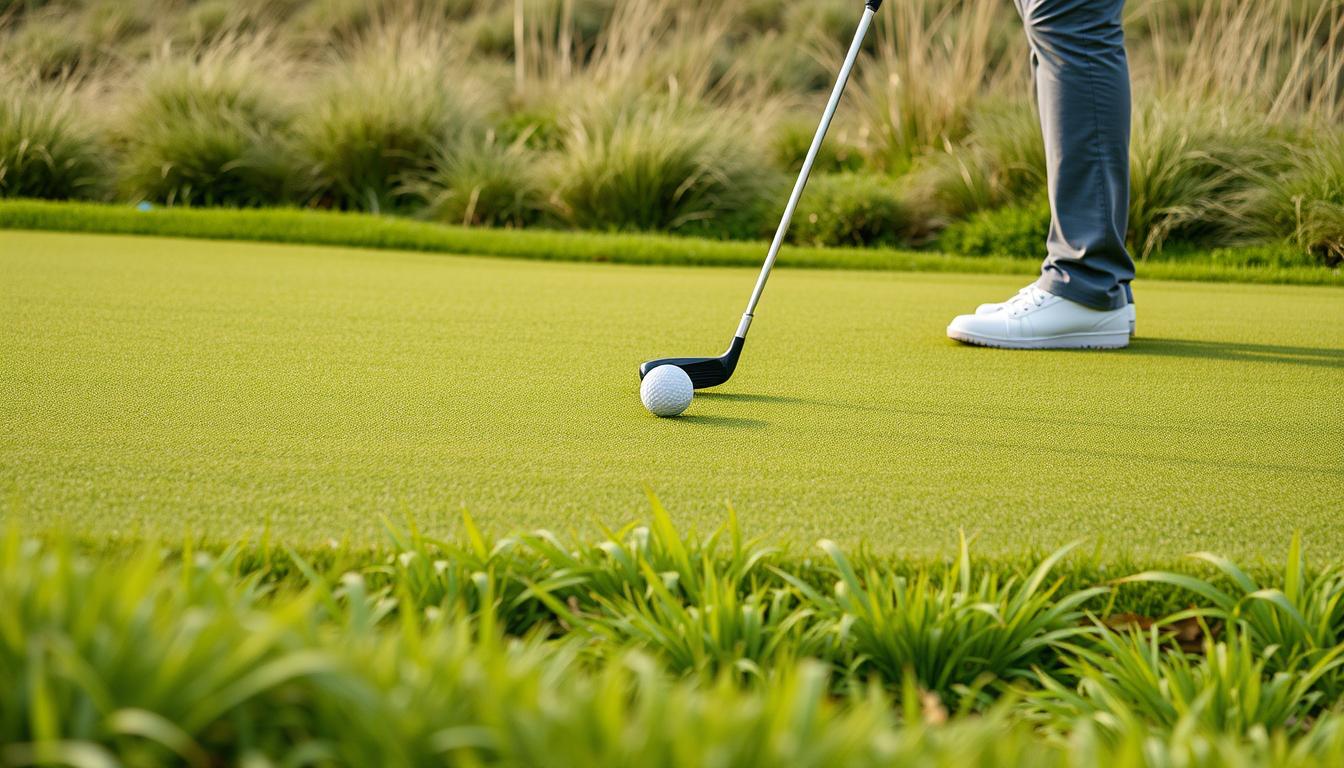Did you know that 419 Tifway Bermuda Grass has been the most popular choice for Texas golf courses for years? This fact underscores the significance of picking the right turf for your course. The type of grass chosen can greatly affect both the playability and the green fee details of a course.
Golf course grass is far from ordinary lawn turf. It’s a sophisticated system designed to endure constant play and upkeep. Course managers face numerous hurdles, including drought, disease, and wear from players and carts.
To ensure perfect drainage and optimal growth, golf grass is often planted deeply with a sophisticated drainage system. This meticulous approach is vital for maintaining the pristine conditions golfers expect. Such conditions directly influence greens fees and a course’s reputation.
Climate is an important factor in turf selection. Bermudagrass excels in the warm climates of the American South, while Bentgrass is favored in cooler coastal areas. Fescue is ideal for courses in the Northeast and Upper Midwest, offering a links-style look with lower maintenance requirements.
Key Takeaways
- Bermudagrass is the top choice for warm climates, known for fast growth and drought tolerance.
- Bentgrass excels in cooler regions but requires heavy maintenance.
- Zoysia offers a middle ground with heat tolerance and low maintenance needs.
- Local climate is crucial in determining the best grass type for a course.
- Proper irrigation and fertilization are essential for maintaining healthy golf course turf.
Table of Contents
- 1 Understanding the Importance of Golf Course Grass
- 2 Factors Influencing Golf Turf Selection
- 3 Common Golf Course Grass Types
- 4 Bentgrass: The Cool-Season Favorite
- 5 Bermudagrass: Thriving in Warm Climates
- 6 Fescue: The Links-Style Choice
- 7 Zoysia: The Versatile Transition Zone Grass
- 8 Kentucky Bluegrass: Northern Golf Course Staple
- 9 Poa Annua: The Controversial Putting Green Grass
- 10 Seashore Paspalum: Salt-Tolerant Option for Coastal Courses
- 11 Ryegrass: Overseeding and Transition Zone Solution
- 12 Maintaining Different Golf Course Grass Types
- 13 Case Studies: Famous Golf Courses and Their Grass Types
- 14 How Grass Types Affect Golf Course Playability
- 15 Innovations in Golf Course Grass Management
- 16 Challenges in Maintaining Different Grass Types
- 17 Choosing the Right Grass for Your Golf Course
Understanding the Importance of Golf Course Grass
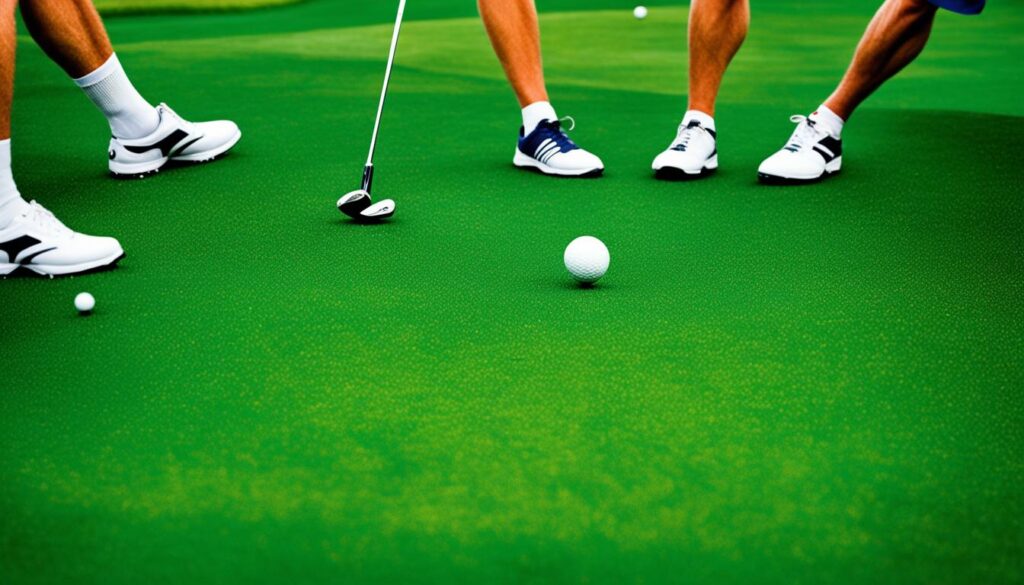
Golf course grass is crucial for the game’s essence. The right turf significantly influences your golfing experience. Next we will look at why selecting the ideal grass is so crucial.
Impact on Playability and Performance
Grass types alter how the ball rolls and how clubs interact with the turf. Bentgrass offers a perfect putting surface with its soft texture. This enhances putting precision thanks to its low cut height. Bermuda grass, however, is tough on fairways but challenges ball positioning with its dense blades.
Aesthetic Appeal and Course Reputation
Golf course aesthetics draw players in. Kentucky Bluegrass, with its deep green hue, creates stunning landscapes. Ryegrass keeps the course vibrant in winter, boosting its beauty. These visuals greatly affect booking rates and course popularity.
Environmental Considerations
The environmental impact of golf course grass is a pressing issue. Zoysia grass requires less maintenance, reducing water and chemical use. Seashore Paspalum excels in salty conditions, perfect for coastal courses without high freshwater demands.
| Grass Type | Climate Suitability | Maintenance Level | Environmental Benefits |
|---|---|---|---|
| Bentgrass | Cool | High | Fine texture, less mowing |
| Bermudagrass | Warm | Medium | Drought-resistant |
| Zoysia | Transition zones | Low | Water-efficient |
| Kentucky Bluegrass | Cool | Medium | Erosion control |
Choosing the right grass type affects playability, aesthetics, and environmental sustainability. Golf course managers must weigh these factors to offer an outstanding golfing experience. They must also consider ecological responsibilities.
Factors Influencing Golf Turf Selection

Choosing the right grass for your golf course is a complex decision. It impacts how the course plays and looks. Let’s look at the important factors that influence turf selection.
Climate and Geographic Location
The climate of your course is pivotal in turf selection. Warm-season grasses like Bermuda and Zoysia excel in southern climates. They are resilient against disease and endure heavy foot traffic. On the other hand, cool-season grasses such as bentgrass and Kentucky bluegrass are ideal for colder regions. Each type offers distinct advantages for specific climates.
Soil Conditions and Drainage
Soil type and drainage significantly impact turf health. Sandy soils drain swiftly but may require additional watering. Conversely, clay soils retain water but can lead to waterlogging. Ensuring proper drainage is crucial to prevent root rot and disease. Certain grasses, like fescue, exhibit remarkable drought tolerance and bounce back quickly from foot traffic.
Maintenance Requirements and Budget
Diverse grasses demand different levels of upkeep, influencing maintenance costs. For instance, Bermuda grass is drought-resistant, making it suitable for dry areas. Conversely, bent grass necessitates more attention but provides a superior playing surface. Your financial constraints will dictate whether you opt for high-maintenance or low-maintenance options.
| Grass Type | Climate | Maintenance Level | Cost per Sq Ft |
|---|---|---|---|
| Bermuda | Warm | Medium | $1-$2 |
| Bentgrass | Cool | High | $1.50-$2.50 |
| Zoysia | Transition | Low | $1-$2 |
| Fescue | Cool | Low | $0.75-$1.50 |
The ideal turf selection harmonizes climate adaptation, soil conditions, and maintenance costs. It’s about finding the perfect match for your unique golf course requirements.
Common Golf Course Grass Types
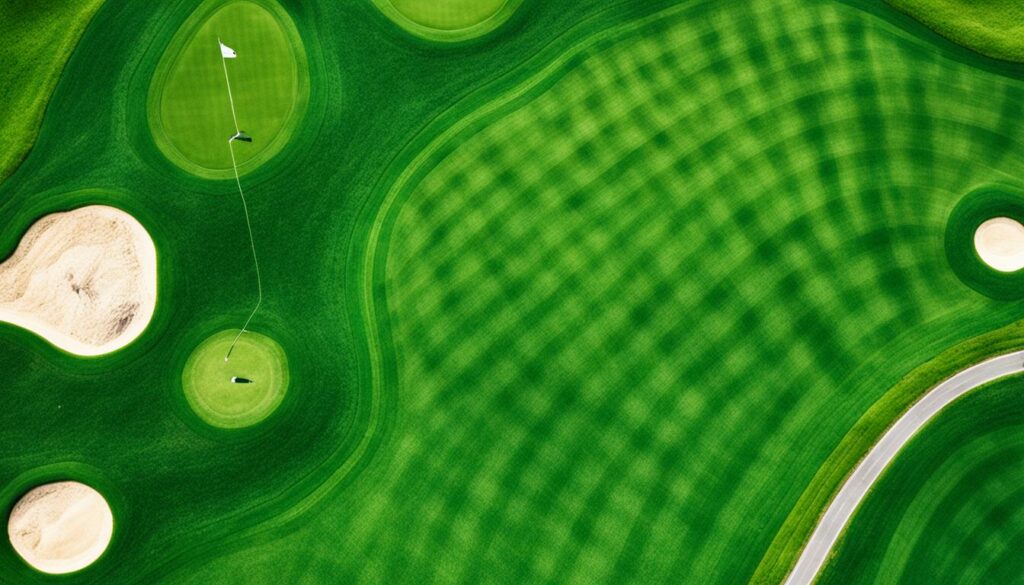
Golf grass varieties are essential for the game’s character. They fall into two main categories: warm-season grasses and cool-season grasses. Each type excels in certain climates and demands specific care.
In hot regions, warm-season grasses reign supreme. The American South’s golf courses often feature Bermudagrass, with the 419 Tifway Bermuda Grass being a top choice across the U.S. Zoysia, known for its resilience and low water usage, is another popular warm-season grass.
Cool-season grasses, on the other hand, flourish in milder climates. Bentgrass is prevalent in areas with cool summers, such as the Pacific Northwest and New England. Fescue excels in the Northeast, Northwest, and Upper Midwest. Ryegrass, ideal for tee boxes and fairways, thrives in cooler temperatures.
Climate is just one factor in grass selection. Traffic resilience and recovery speed are equally crucial. Selecting the right grass type affects course maintenance fees and playability.
| Grass Type | Climate | Notable Courses |
|---|---|---|
| Bermudagrass | Warm | TPC Sawgrass, PGA National |
| Bentgrass | Cool | Augusta National, Muirfield Village |
| Poa Annua | Cool | Torrey Pines, Pebble Beach |
Understanding these grass types reveals the diverse challenges each golf course presents. From the fast Bermuda greens to the slower Poa Annua surfaces, each variety offers a distinct playing experience.
Bentgrass: The Cool-Season Favorite
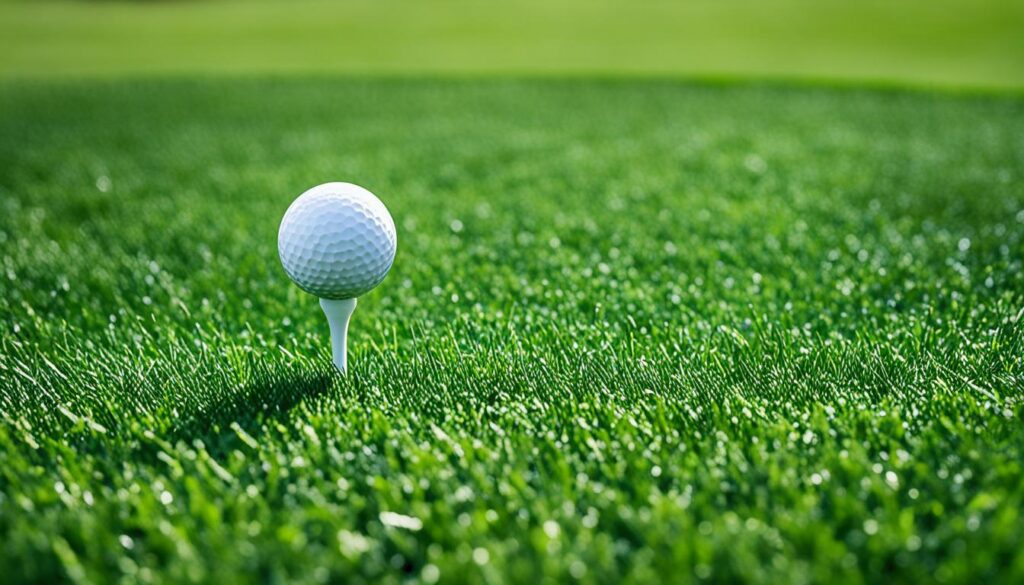
Bentgrass is a leading choice for cool-season grass on golf courses. Its thin blades and resilience to close mowing make it ideal for smooth, fast greens. It thrives in coastal areas, the North, Mid-Atlantic, and Midwest regions of the United States.
Characteristics and Ideal Growing Conditions
Bentgrass excels in spring and fall, particularly in the Northeast. It thrives in cooler climates and coastal areas. This grass type can be mown very low, creating an ideal surface for putting greens. Its fine texture and minimal grain ensure consistent ball roll, enhancing the golfing experience.
Maintenance Challenges and Solutions
Golf course maintenance of bentgrass presents challenges. In hot summers, it requires substantial watering to remain healthy. Bentgrass may turn slightly brown, but it’s often at its best when slightly stressed. To maintain bentgrass effectively, focus on proper irrigation, regular mowing, and careful monitoring of turf health.
Best Uses on the Golf Course
Bentgrass excels on putting greens and fairways. Its ability to tolerate low mowing heights makes it perfect for fast, smooth putting surfaces. Many golf courses use bentgrass on fairways, providing excellent playing conditions during the cool-season months.
| Feature | Bentgrass Characteristics |
|---|---|
| Blade Texture | Fine and thin |
| Mowing Height | Very low (0.100″ – 0.125″ for greens) |
| Water Requirements | High during summer months |
| Best Climate | Cool-season regions |
| Primary Use | Putting greens and fairways |
Bermudagrass: Thriving in Warm Climates
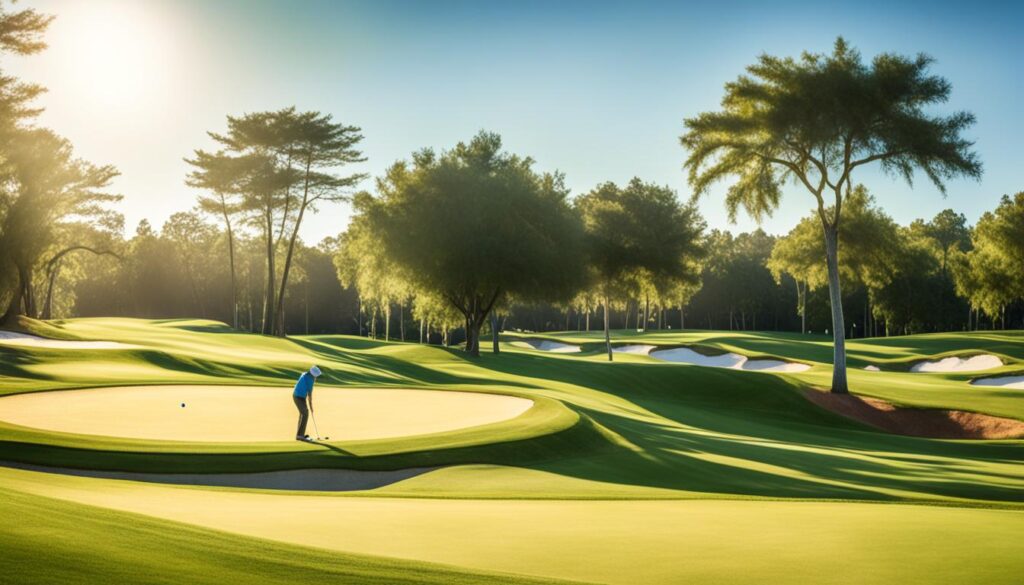
Bermudagrass is a leading choice for golf courses in sunny areas. It excels in hot climates, making it ideal for Southern courses. Its resilience and ability to handle heavy foot traffic distinguish it from other turf types.
Golf course managers appreciate bermudagrass for its drought tolerance. It needs less water than cool-season grasses, essential in dry areas. The United States Golf Association (USGA) notes significant benefits from using bermudagrass in drought-prone and hot summer regions.
When mown closely, bermudagrass offers a firm, fast, and true playing surface. It excels in full sunlight, providing optimal playing conditions. Available in seeded and hybrid forms, the hybrid type is often denser and darker green.
| Golf Course | Green Fees | Tee Times |
|---|---|---|
| Pinehurst Resort | $495 | 7:00 AM – 5:00 PM |
| TPC Sawgrass | $600 | 7:30 AM – 4:30 PM |
| Kiawah Island Golf Resort | $383 | 6:30 AM – 6:00 PM |
Bermudagrass grows aggressively, recovering quickly from damage. This is crucial for high-traffic golf course areas. Although it may go dormant in cooler months, proper management keeps it playable all year.
Fescue: The Links-Style Choice
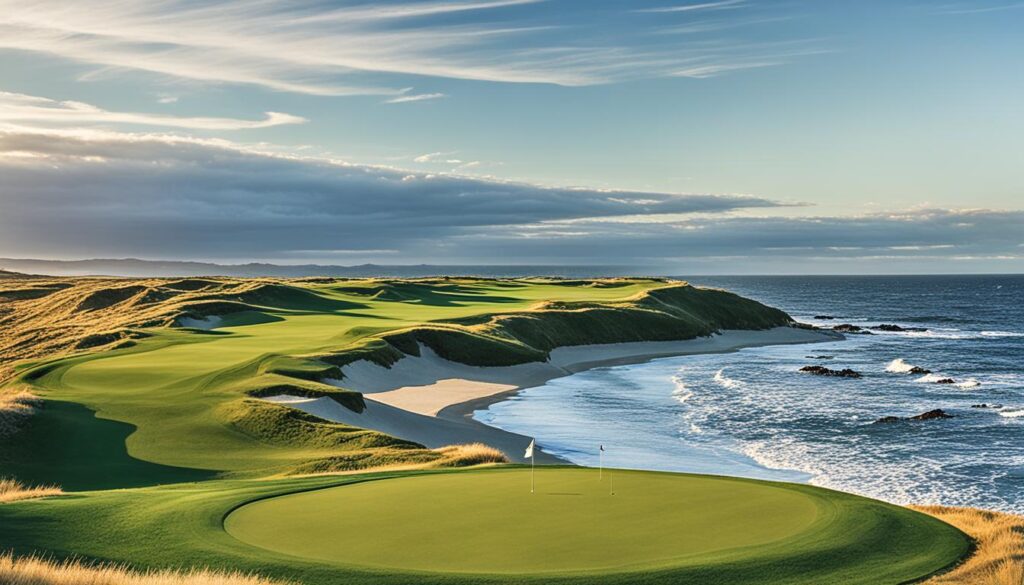
Fescue grass is a top pick for links-style courses, combining beauty with practicality. It brings the authentic seaside golf feel to inland courses. It also offers practical benefits for managing the course.
Fine Fescue vs. Tall Fescue
Fescue grass has two main types: fine and tall. Fine fescue, used on greens and fairways, provides a firm, fast playing surface. Tall fescue, perfect for rough areas, enhances the course’s look and challenges players. Royal Liverpool Golf Club uses fine fescues like Browntop Bent, Slender Creeping Red Fescue, and Chewings Fescue for their greens.
Drought Tolerance and Low Maintenance Benefits
Fescue grass is known for its drought tolerance and low maintenance needs. It has deeper roots than other grasses, requiring less water and fertilizer. This makes it an eco-friendly option for golf courses aiming to cut down on water and chemical use.
Creating Natural Hazards and Aesthetic Appeal
Fescue grass gives links-style courses a unique look. Its upright growth forms natural hazards and makes balls appear “teed up”. Many top courses, like Bandon Dunes and Whistling Straits, use fescue for its beauty and playability.
| Golf Course | Green Fee (Weekday) | Green Fee (Weekend) | Tee Times |
|---|---|---|---|
| Bandon Dunes | $295 | $295 | 7:00 AM – 5:00 PM |
| Whistling Straits | $410 | $460 | 7:30 AM – 4:30 PM |
| Royal Liverpool | £250 | £250 | 8:00 AM – 4:00 PM |
While fescue has many benefits, it prefers sandy, well-draining soil and doesn’t like wet conditions. This is critical for membership details and course selection for those seeking the real links experience.
Zoysia: The Versatile Transition Zone Grass
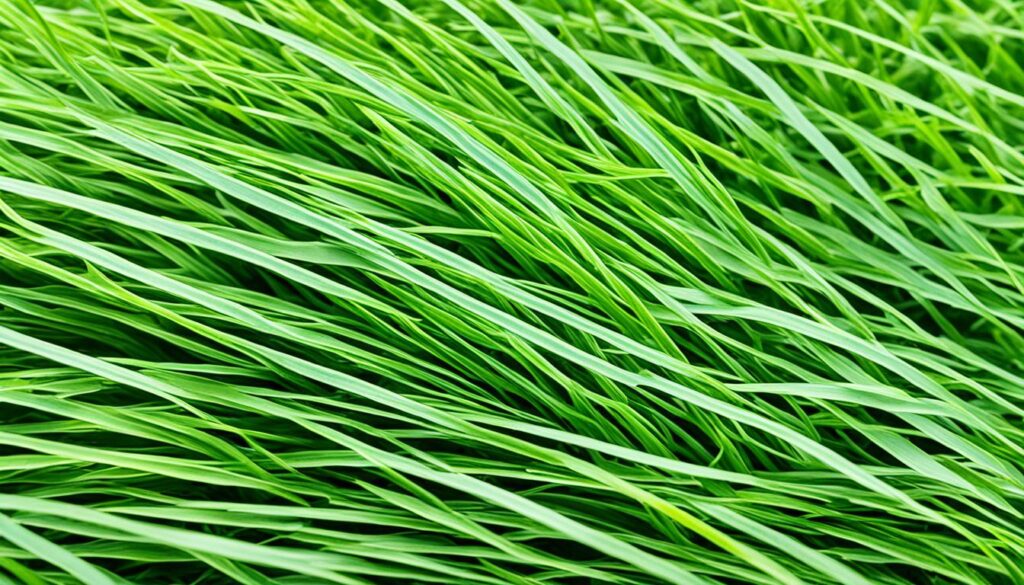
Zoysiagrass is a favored choice for golf courses in the transition zone. It excels in cold tolerance, making it perfect for areas with fluctuating climates. Its versatility and resilience make it a prime selection for course managers aiming for lush, playable turf throughout the year.
This grass is renowned for its drought resilience, needing minimal watering to flourish. It thrives on about 1 inch of water weekly, sourced from either rainfall or irrigation. This characteristic makes it an ideal choice for courses seeking to reduce water usage while maintaining impeccable fairways and roughs.
Zoysiagrass excels in full sunlight but also tolerates some shade, providing flexibility in course layout. Its heat resistance and wear resilience make it ideal for busy areas like tee boxes and fairways. Golf course amenities greatly benefit from its durability, ensuring consistent play throughout the season.
Zoysia Varieties for Golf Courses
Several zoysia varieties stand out in golf course settings. Cavalier Zoysia leads in NTEP trials across 24 locations, while Emerald Zoysia remains green longer in southern climates. Geo Zoysia, a newer hybrid, offers top-notch performance with minimal maintenance.
| Zoysia Variety | Best Use | Mowing Height | Shade Tolerance |
|---|---|---|---|
| Cavalier | Fairways, Roughs | 1-2 inches | Moderate |
| Emerald | Tees, Fairways | 0.5-1 inch | Good |
| Geo | All Areas | 1-2 inches | Excellent |
When planning your course, consider the unique types of hazards on golf courses and how zoysiagrass can enhance these features. Its adaptability to various soil types and superior weed control capabilities make it a wise choice for creating challenging yet aesthetically pleasing playing surfaces.
Kentucky Bluegrass: Northern Golf Course Staple
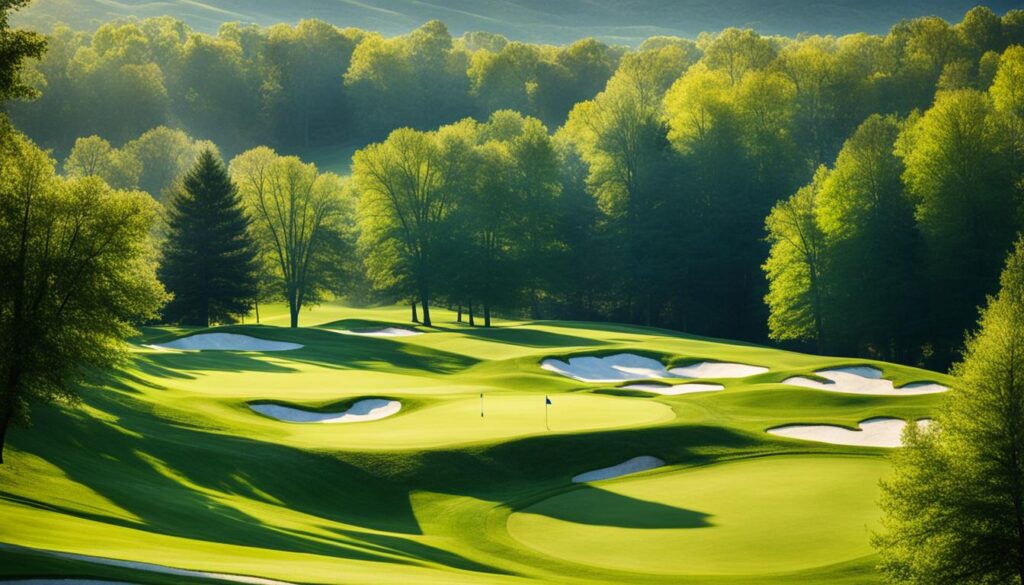
Kentucky bluegrass is a favored choice for northern golf courses. It excels in colder climates, providing a lush appearance that golfers adore. Its resilience in harsh winters makes it a dependable choice for courses facing freezing temperatures.
Lush Appearance and Cold Tolerance
The deep green color of Kentucky bluegrass enhances the visual appeal of a golf course. Its fine texture and dense growth pattern contribute to its luxurious appearance. This grass type enters dormancy during winter but rapidly recovers in spring, ensuring its beauty throughout the growing season.
Mixing with Other Grass Types for Optimal Performance
Golf course managers frequently blend Kentucky bluegrass with other cool-season grasses to improve performance. This strategy creates a more resilient turf capable of withstanding various playing conditions and environmental stresses. A common approach involves combining three or four different Kentucky bluegrass varieties for superior results.
| Grass Type | Maintenance Level | Climate Suitability | Benefits |
|---|---|---|---|
| Kentucky Bluegrass | Medium | Northern States | Cold tolerance, lush appearance |
| Bentgrass | High | Northern States | Fast greens, fine texture |
| Perennial Ryegrass | Medium to High | Northern States | Quick establishment, wear tolerance |
While Kentucky bluegrass provides numerous benefits, it demands proper care to sustain its quality. Adequate irrigation is crucial, particularly in drier regions. In humid climates, the grass may face disease and heat stress, necessitating vigilant management to maintain your golf course’s excellence.
Poa Annua: The Controversial Putting Green Grass
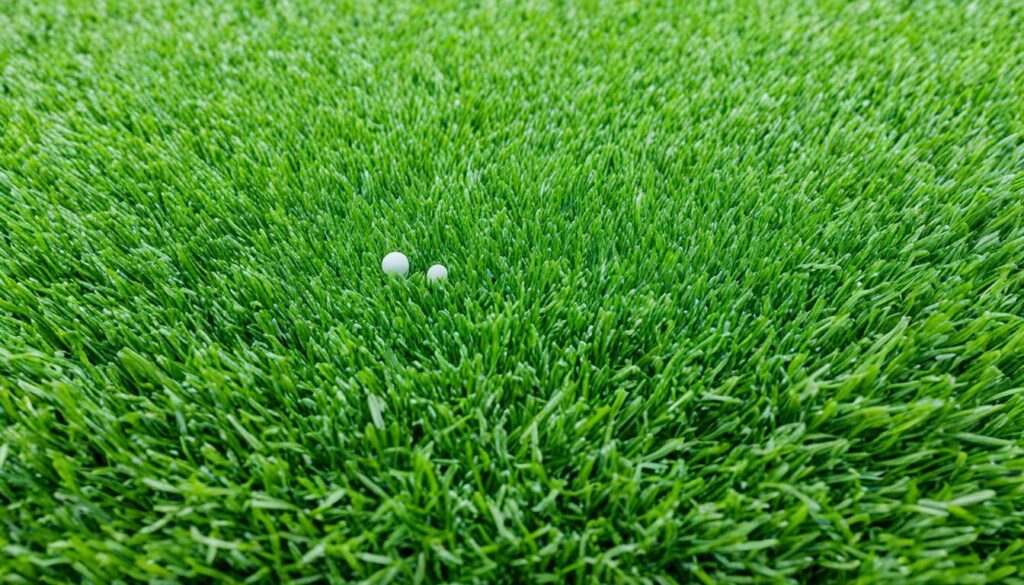
Poa annua, commonly known as annual bluegrass, has sparked debate in the golfing community. It’s prevalent on putting greens in the U.S., particularly in the north. This grass is celebrated for its unique traits and the challenges it poses in maintenance.
On the greens, poa annua offers a smooth surface that many golfers prefer. It grows swiftly and excels in low mowing conditions. Also it prospers in damp, shaded spots, outperforming other grasses under such conditions. These attributes make it resilient on busy courses with heavy foot traffic.
However, poa annua also has its downsides. It produces seedheads that can roughen the greens in the late afternoon. Moreover, it requires meticulous care to maintain its quality. Golf course managers often grapple with the decision of whether to control or accept poa annua on their greens.
Some elite courses have embraced poa annua. Winged Foot and Pebble Beach, for instance, feature this grass on their renowned greens. These clubs have successfully managed poa annua, showcasing that with the right approach, it can enhance the golfing experience.
| Golf Course | Green Fee | Tee Time Availability |
|---|---|---|
| Pebble Beach Golf Links | $595 | Limited guest access, resort stay required |
| Winged Foot Golf Club | $350 (member guest) | Private, limited guest access |
For golf enthusiasts, grasping poa annua’s significance on putting greens can deepen your understanding of course design and upkeep. Next time you’re on a green, pause to appreciate the grass beneath your feet. It might just be the intriguing poa annua.
Seashore Paspalum: Salt-Tolerant Option for Coastal Courses
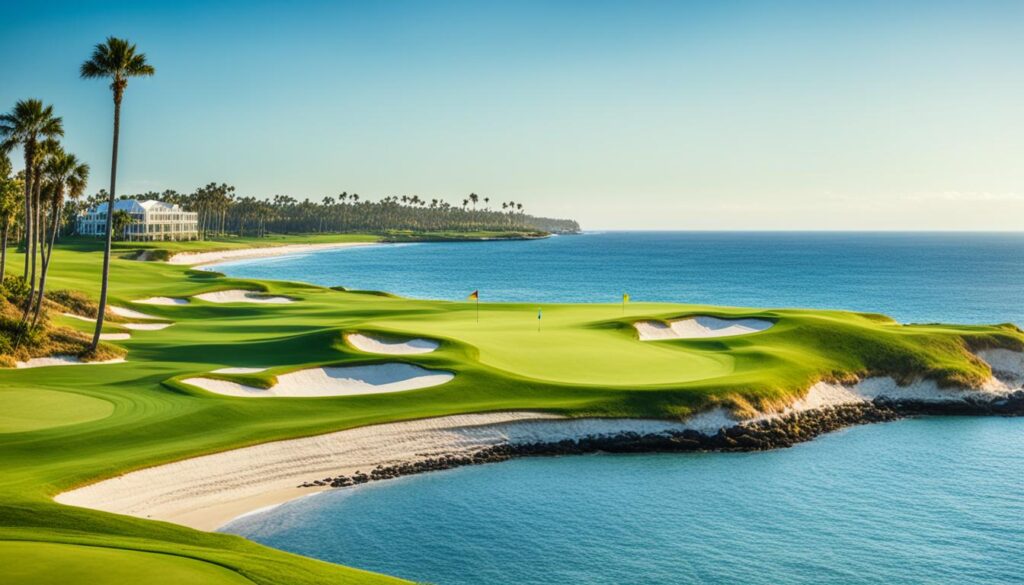
Seashore paspalum is revolutionizing coastal golf courses. This grass excels in salty soils and tolerates high-salinity irrigation. It’s particularly favored in southern U.S. courses, especially in Texas.
Unique Characteristics and Advantages
Seashore paspalum is renowned for its drought resilience. It requires less water than other grasses, making it an eco-friendly choice. Also it demands less nitrogen fertilizer than bermudagrass, reducing maintenance expenses.
Golf course managers appreciate seashore paspalum for its adaptability. It excels on fairways, tees, and high-traffic zones. The grass forms a dense canopy that recovers swiftly from wear, ideal for busy courses with strict guest policies.
Maintenance Tips for Optimal Growth
To ensure seashore paspalum thrives, follow these guidelines:
- Mow at heights between 1/8 to 2 inches
- Water deeply but less often once established
- Apply 2-3 pounds of nitrogen per 1,000 square feet yearly
- Use sharp mower blades and never cut more than 1/3 of the leaf blade
Seashore paspalum brings distinct advantages to coastal golf courses. Its salt tolerance and low maintenance requirements make it a wise selection for managers aiming to enhance playability while promoting sustainability.
| Grass Type | Salt Tolerance | Drought Tolerance | Nitrogen Needs |
|---|---|---|---|
| Seashore Paspalum | Excellent | Excellent | Low |
| Bermudagrass | Good | Good | High |
| Zoysiagrass | Moderate | Good | Moderate |
Ryegrass: Overseeding and Transition Zone Solution
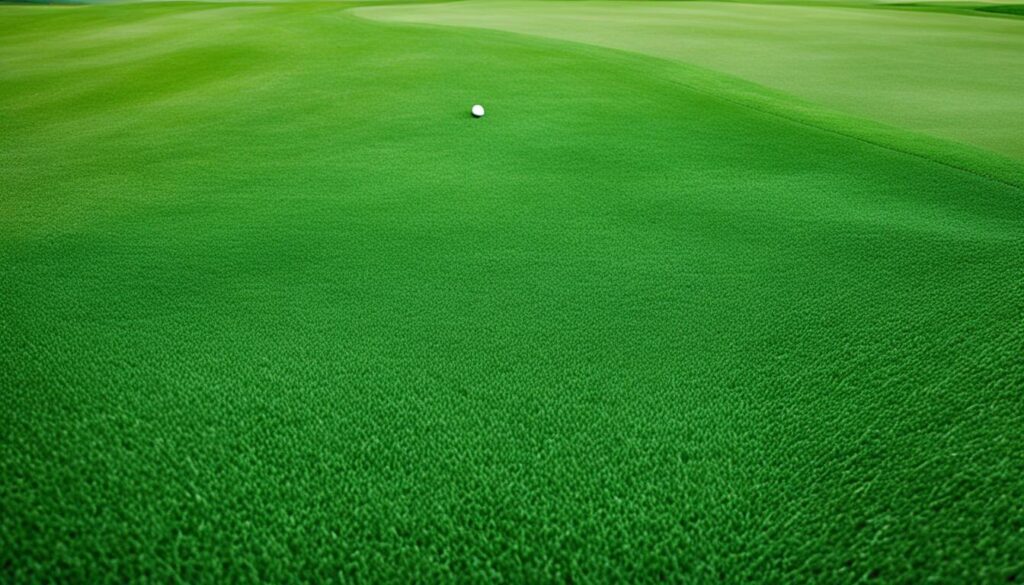
Ryegrass is a top choice for golf courses, especially in the transition zone. Its unique traits make it perfect for overseeding, offering vibrant winter color and better playability. Golf courses across the U.S. use ryegrass to keep fairways lush and green all year.
In southern states, where bermudagrass is common, ryegrass is critical for winter overseeding. About 95% of golf courses in southern Arizona and California’s Coachella Valley use this method. In Texas, 2% of courses fully overseed, but 30% do it in high-traffic spots like tees and driving ranges.
Ryegrass varieties are known for their resilience. Hancock’s Perennial Ryegrass excels in salt and wear resistance. Champion GQ Perennial Ryegrass Seed fights off common turf diseases, boosting course durability. These traits make ryegrass a top pick for keeping courses in top shape, essential for precise distance readings and club selection.
The overseeding process starts in mid-October. It takes 10-12 days to germinate, with some courses stopping play for even coverage. This effort costs about $4,175 per acre in 2021, due to rising water and seed prices.
| Ryegrass Feature | Benefit |
|---|---|
| Rapid establishment | Quick turnaround for scheduled events |
| Disease resistance | Reduced maintenance costs |
| Winter color | Improved aesthetics during cold months |
| Wear tolerance | Better playability in high-traffic areas |
While ryegrass has many advantages, some courses are looking at alternatives. The USGA backs research on warm-season grasses that stay green all year. Others use grass-friendly paint on fairways and greens, finding a balance between looks and sustainability in golf course management.
Maintaining Different Golf Course Grass Types
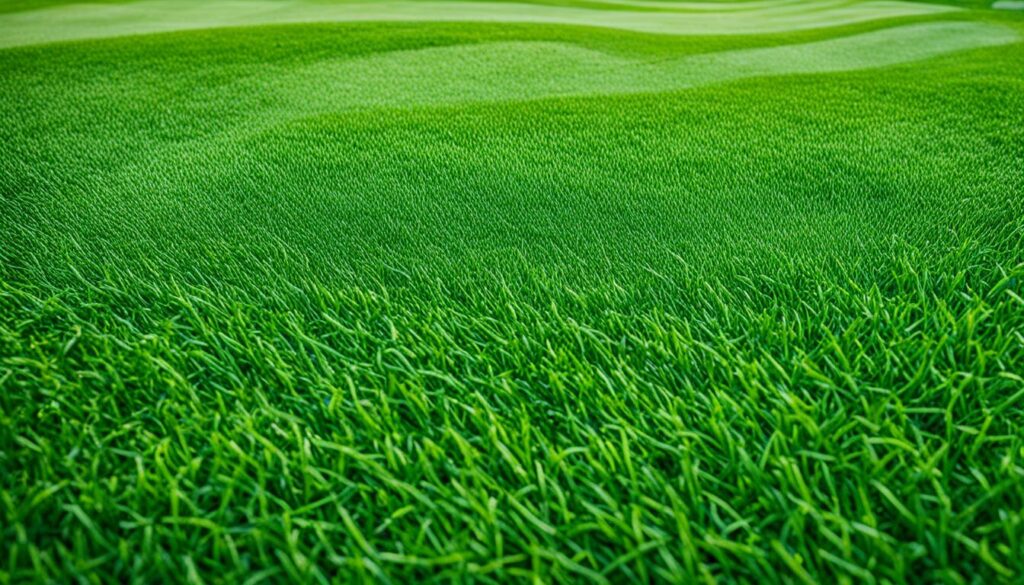
Golf course maintenance demands a deep understanding of various grass types and their care. The choice of grass significantly influences playability, aesthetics, and the overall design of the course. Let’s look at the important aspects of maintaining different golf course grasses.
Mowing Techniques and Frequency
Proper mowing is essential for golf course upkeep. In spring and fall, cut the grass to approximately 0.140 inches. During the summer, reduce the height to 0.100 inches. Most courses mow six times a week to maintain the turf in prime condition.
Irrigation and Water Management
Effective irrigation is crucial for maintaining healthy turf. The watering needs differ by grass type and climate. Bentgrass, prevalent in moderate climates, requires more frequent watering. In contrast, Zoysia and Bermuda grasses, found in warmer areas, are more resilient to drought.
Fertilization and Pest Control Strategies
Regular fertilization ensures the grass remains lush and vibrant. Pest control is equally crucial. A tailored strategy is necessary, considering the specific grass type and local climate. For instance, Poa annua on the West Coast may require different treatments than Bermuda grass in southern regions.
| Grass Type | Best Climate | Maintenance Level |
|---|---|---|
| Bentgrass | Moderate | High |
| Bermuda | Warm | Medium |
| Zoysia | Warm to Transition | Low |
| Kentucky Bluegrass | Cool | Medium |
Golf course grass maintenance is not a one-size-fits-all endeavor. It is crucial to tailor your approach to the grass type, climate, and course design for the best results.
Case Studies: Famous Golf Courses and Their Grass Types
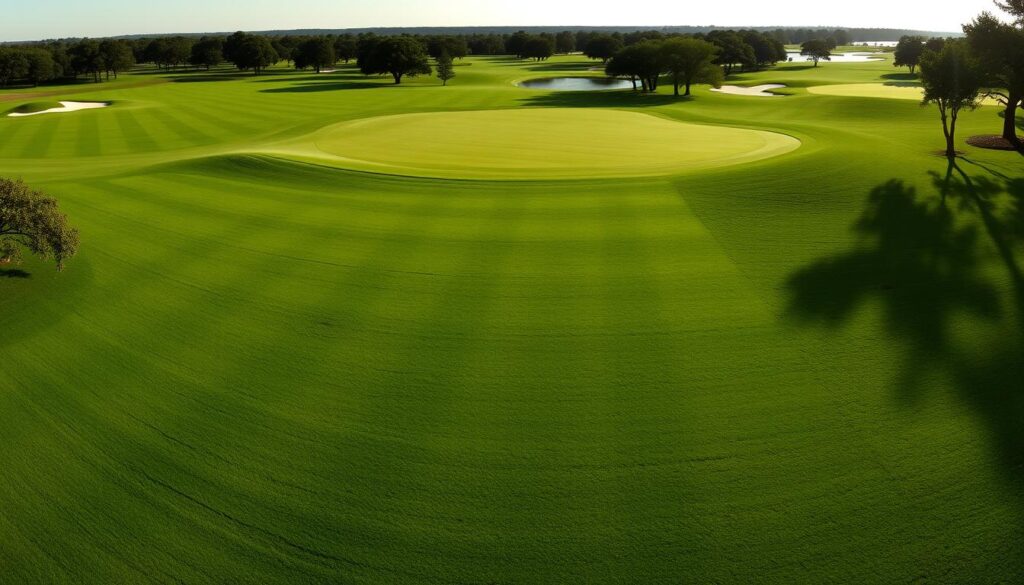
Golf enthusiasts dream of playing on famous golf courses. These iconic venues showcase various grass types, each contributing to unique playing experiences. Next we will look at three renowned courses and their turf choices.
Augusta National Golf Club
Augusta National, home of the Masters Tournament, is known for its pristine conditions. The course uses overseeded ryegrass on fairways, providing a lush green carpet year-round. Augusta’s bentgrass greens are famous for their speed and smoothness.
Pebble Beach Golf Links
Pebble Beach, with its stunning ocean views, features poa annua on its greens. This grass type thrives in the coastal climate, offering consistent putting surfaces. The fairways blend ryegrass and Kentucky bluegrass for durability.
St. Andrews Links
The Old Course at St. Andrews, the birthplace of golf, embraces a links-style layout. Fescue grasses dominate here, creating firm and fast playing conditions. These grasses require less water and maintenance, aligning with the course’s natural aesthetic.
| Golf Course | Green Fee (USD) | Tee Time Availability |
|---|---|---|
| Augusta National | N/A (Members only) | Limited (Invite only) |
| Pebble Beach | 575 | Year-round |
| St. Andrews (Old Course) | 290 | April – October |
These famous golf courses demonstrate how different grass types can create unique playing experiences. From Augusta’s manicured ryegrass to St. Andrews’ rugged fescue, each choice reflects the course’s climate, style, and maintenance approach.
How Grass Types Affect Golf Course Playability
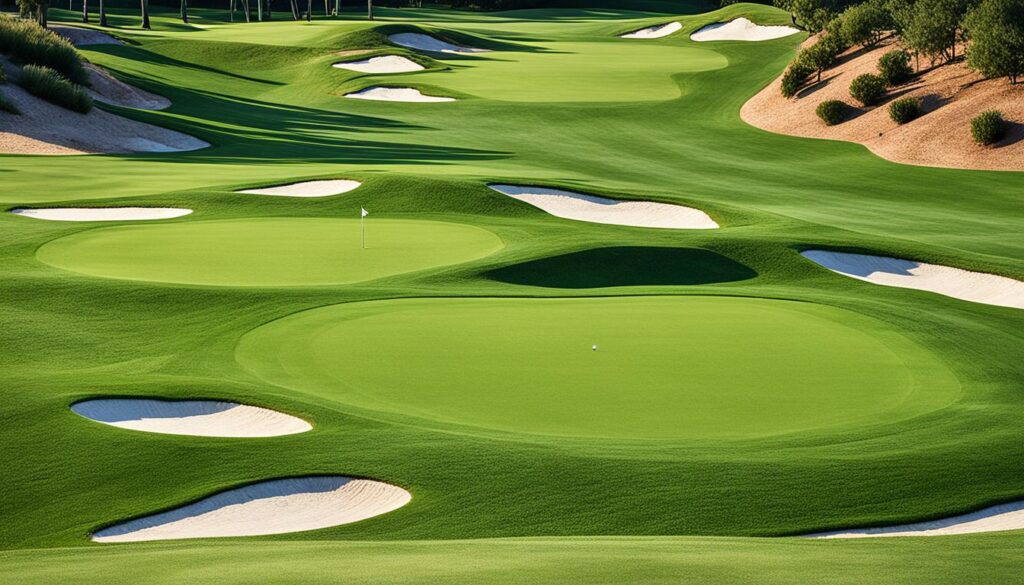
Golf course playability is deeply influenced by the grass types used. These grasses affect the ball’s roll, the condition of the fairway, and the scenic beauty of the course. Let’s look at how the choice of grass shapes your golfing experience.
Impact on Ball Roll and Speed on Greens
The type of grass significantly impacts the putting surfaces. Bentgrass, prevalent in private clubs, provides smooth, swift greens. Augusta National’s bentgrass greens, maintained daily, ensure exceptional ball roll. On the other hand, Poa Annua can lead to uneven putting surfaces, especially when mixed with other grasses.
Influence on Fairway and Rough Conditions
The grass in the fairway influences the ball’s lie and shot execution. Kentucky Bluegrass offers a better ball rest for higher handicap golfers. In contrast, Bermudagrass, widespread in southern states, creates a challenging rough with thick stolons that hinder ball advancement. Zoysiagrass, while providing good ball position, can cause sticky bounces on short game shots.
Seasonal Changes and Their Effects on Play
Grass types exhibit varying responses to seasons, affecting play throughout the year. Ryegrass is often overseeded in southern regions during winter, later replaced by heat-tolerant Bermudagrass. Paspalum grass excels in coastal areas, maintaining excellent playing conditions despite salt exposure.
| Grass Type | Best Season | Playing Characteristics |
|---|---|---|
| Bentgrass | Cool seasons | Fast, smooth greens |
| Bermudagrass | Warm seasons | Firm fairways, challenging rough |
| Ryegrass | Winter (overseeding) | Lush appearance, good ball support |
| Paspalum | Year-round in coastal areas | Salt-tolerant, consistent playability |
Innovations in Golf Course Grass Management
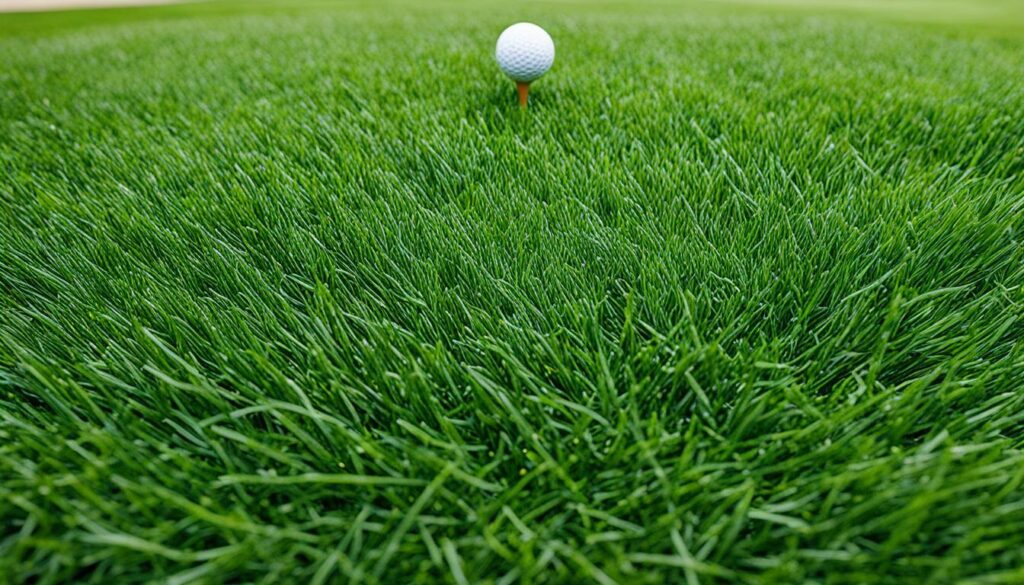
Golf course management has witnessed a significant surge in turfgrass innovations. These advancements aim to improve playability and support sustainable practices. The industry is evolving with high-tech tools and eco-friendly methods to address modern challenges.
Advances in Turfgrass Science and Technology
New technology is transforming how facilities maintain their greens. GPS-guided mowers ensure uniform grass height across fairways and greens. Smart irrigation systems adjust watering based on real-time weather data, optimizing water usage. Soil sensors provide instant data on moisture and nutrient levels, allowing for precise care.
Sustainable Practices and Eco-Friendly Maintenance
Golf courses are embracing sustainable practices to reduce their environmental impact. Robotic mowers trim grass autonomously, saving time and labor. Drones offer aerial views for detailed analysis of grass health. These tools help identify problem areas quickly, reducing the need for widespread chemical treatments.
Use of Hybrid and Genetically Modified Grass Types
Hybrid grasses are becoming popular for their resilience and visual appeal. These varieties are developed to resist pests, diseases, and environmental stressors. For instance, bentgrass seed, with 3.5 to 7 million seeds per pound, is harvested once a year in Oregon’s Willamette Valley. This region’s climate is ideal for producing high-quality grass seeds.
| Innovation | Benefit |
|---|---|
| GPS-guided mowers | Consistent grass height |
| Smart irrigation | Optimized water usage |
| Soil sensors | Precise care and fertilization |
| Robotic mowers | Labor and time savings |
| Hybrid grasses | Improved resilience and appearance |
These turfgrass innovations are shaping the future of golf course management. By embracing technology and sustainable practices, golf facilities can maintain pristine playing conditions while minimizing their environmental footprint.
Challenges in Maintaining Different Grass Types
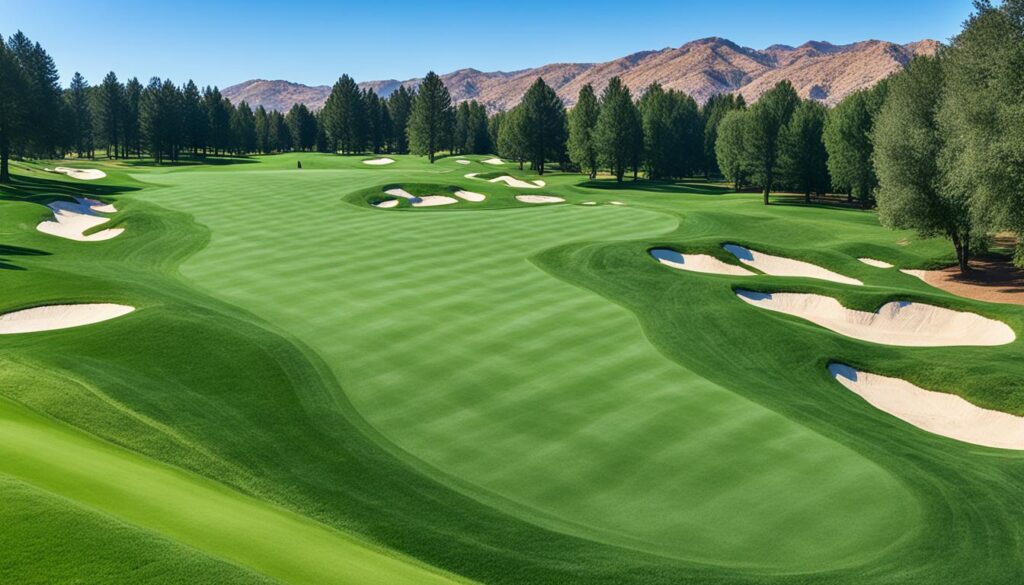
Golf course maintenance is a complex task that requires careful attention to various grass maintenance challenges. From pest management to weather impacts, superintendents face numerous obstacles in keeping courses in top shape for tee time bookings.
Pest and Disease Management
Dealing with pests and diseases is a significant challenge in turf care. Different grass types face various issues. For instance, Poa annua, common in Northeast greens, is highly susceptible to freezing temperatures. Effective pest management strategies are essential for maintaining healthy turf.
Seasonal Transitions and Weather Impacts
Weather significantly impacts grass health. Courses in the Northeast face unique challenges with tree shade, rocky soil, and climate swings. Rising temperatures can stress turf, especially on rocky soils. Winter weather often damages greens, requiring specialized care and preparation.
Balancing Aesthetics with Playability
Maintaining the perfect balance between looks and performance is challenging. Older courses with smaller, undulated greens need tailored maintenance to preserve their character while ensuring playability. This balance affects tee time bookings and overall course reputation.
| Grass Type | Climate | Maintenance Challenge |
|---|---|---|
| Bermuda | Warm | Grain management for putting |
| Bentgrass | Cool | Heat stress in summer |
| Zoysia | Various | Slow growth and recovery |
| Ryegrass | Cool/Transitional | Overseeding timing |
Choosing the Right Grass for Your Golf Course
Selecting the perfect turf for your golf course is essential for an exceptional playing experience. The choice of grass depends on climate adaptation and maintenance needs. In the Northeast, cool-season grasses like Kentucky bluegrass excel. The Southeast and Southwest prefer heat-tolerant Bermudagrass. Meanwhile, the Midwest often chooses perennial ryegrass for its vibrant color and moderate drought resistance.
In the Transition Region, tall fescue is favored for its deep roots and low maintenance. The Deep South and Gulf Coast areas benefit from Bahiagrass and Centipedegrass, which are resilient to drought and pests. Temperature significantly impacts grass growth and how the ball behaves on the course.
When planning your golf course, consider the long-term effects of your grass choice on playability and maintenance costs. Zoysia grass is becoming popular for its adaptability and low water needs. However, Poa Annua, while beautiful on West Coast courses, can lead to uneven putting surfaces. By carefully evaluating these factors, you can ensure your course offers an optimal golfing experience and attractive tee times for years ahead.
